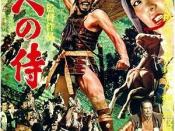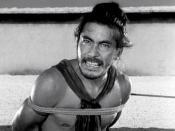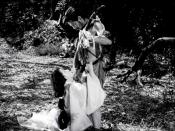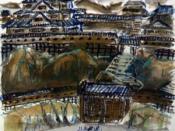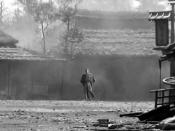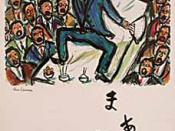Kurosawa and A Fist Full OF Dollars.
This essay is about Kurosawa and his work as an auteur. In this essay I will be talking about Kurosawa?s life and work?s. I will be looking at some of his most famous films, but will be concentrating on ?Yojimbo? (1961) and it similarities and dissimilarities to ?A Fist Full of Dollars? (1964).
Akira Kurosawa was born March 23 1910 in Omori, Tokyo. His farther was a soldier for the Japanese army and was a firm believer in the ways of the samurai and implemented them on his children. Which is evident in most of Kurosawa?s films. He trained at university as an artist, but in 1936 went into the Japanese film industry as a scriptwriter.
He directorial debut was in 1943 with ?Judo Saga,? but as you would expect a lot of his material was censored due to the Second World War.
Japan did not want any negative portrayals of men, much of this censored material would never be found.
Kurosawa went on unnoticed until 1950 when the release of ?Rashomon? won him the Grand Prix at the Venice film festival. It was the first film from Asia to get recognition from the West. He went on to make ?The Seven Samurai? and ?Throne of Blood?. In all these films he was to showcase an up and coming charismatic actor by the name of Toshiro Mifune. Mifune also stared in ?Hidden Fortress? which George Lucas cites as a major influence for ?Star wars?.
Another film that starred Mifune was ?Yojimbo? that was directed by Kurosawa and some say his best work. Yojimbo (The Bodyguard) is about a Ronin (samurai with no master) at the beginning he sees a mother farther and son arguing. The son is complaining about the lack of food and says he is going to join a band of criminals so that he can survive the mother and farther beg him to stay but he has made up his mind and is leaving. At this point the Ronin is just watching and not helping where as you would expect him to help. The Ronin then goes to a town with two feuding families and sees he can make a little money and plays one family off another. In this film none of the families are good and nor is the Ronin, but the only good thing the Ronin does is rescue a couple and their son from the two feuding families. He gets caught and gets beaten up, but he manages to escape recover and get both families killed. Near the end of the film a son from one of the families has a face off with the Ronin and the Ronin wins even though the son has a gun.
The Ronin in this film is an anti-hero, meaning he is not you stereotypical good guy. Usually someone who is out for themselves but has a hint of good in them. The Ronin in this film doesn't do what you would expect the hero to do like when he enters the town you would expect him to make the town good but he just makes it worse to make himself some money. The Ronin in ?Yojimbo? is not honourable but honest. Heroes in Hollywood at this time were pillars of purity trusting and a friend to everyone. ?Yojimbo? develops the theme of self-assertion and individual integrity; for example he would sell his sword but not his values.
The cinematographer of ?Yojimbo? Kazuo Miyagawa used a lot of techniques while shooting this film one would be the use of deep focus this draws us to only two areas of the screen at a time. The film is also a comedy Kurosawa uses low angles to help out with the comedic tone of some scenes. A good example of this would be the scene near the end when the two families try to destroy each other once and for all. The Ronin climbs a bell tower to see the carnage he has created as if he was watching a boxing match but when you view the Ronin you see him in a dietic view which adds to the affect. An other good way to see that ?Yojimbo? is also a comedy is by looking at the two families they are not really that bright and don?t really ever use their heads. They also look very abnormal physically.
This film did well in the Japanese box office, and also triggered off a string of spaghetti westerns made by Sergio Leonie. His first was a re-make of ?Yojimbo? it was called ?A Fist Full of Dollars? the lead role was Clint Eastwood.
After the Second World War Italy slowly began to make new films, many of them were inexpensive films featuring an American lead role and the rest of the cast would be Italian. The films were shot with the Italian actors speaking Italian and then later on English voices being dubbed on. It was quickly dubbed ?The Spaghetti western.? Spaghetti westerns were really silent films as the speaking and sound effects were usually dubbed on afterwards.
A Fist Full of Dollars is very similar to Yojimbo in fact you could go as far as to say they are practically the same film with different actors and a different settings. A Fist Full of Dollars is set in Mexico and has literary has the same storyline again he plays the two families off each other again he is the anti-hero again he does one good thing by joining the two couples and their son, and so on. Until he has the final duel with the son of one of the families.
This Film also uses a lot of good shots like at the beginning when Eastwood?s character has a drink from the well the ECU is very good because you want him to help the little boy and he does not. Another good shot is at the end when the man in the duel with Eastwood?s character is standing opposite him there is an ECU to show that he is sweating and trembling this shows you how the character is feeling.
One thing about this film was the violence you might not think it now but this was a very violent film in its portrayal of cold-blooded killing. The film also gave a boost to Eastwood?s flaying career.
The best scene to show that A Fist Full of Dollars practically copying Yojimbo was after both lead roles get beaten up the way they escape they both use the floorboards and when the family start to look for them they both look through a crack in the floorboard. The one big difference apart from the obvious on the two films was that A Fist Full of Dollars was meant to be serious Yojimbo was a little more light-hearted. You could see that from the two characters like Eastwood?s character hardly ever talked and always seemed very distant, whereas Mifune?s character was a little more likeable and funnier.
Yojimbo had the more effective and memorable camera shots like when the streets are empty and you see the autumn leaves blowing A Fist Full of Dollars does not have a shot like that. Although it does have a memorable moment like when he has the final showdown the man he is facing told him earlier on in the film that he shoots for the heart so Eastwood?s character uses a piece of metal to cover his chest. Leonie uses good editing here by showing an ECU of the man shooting at Eastwood?s character and when you see a long shot of Eastwood?s character being shot but getting up the ECU shows the frustration on the characters face.
Kurosawa went onto do many big things and won a lot of awards. After a failed suicide attempt he went on to collaborate with Russian cinema to make ?Dersu Uzala?. He also received an Academy Award nomination for his film ?Ran.? ?The Seven Samurai? was also remade as ?The Magnificent Seven? by John Sturges and ?Rashomon? by Martin Ritt as ?The Outrage?. In his later years he went on to make ?Kagemusha? with the help of Francis Ford Coppola and George Lucas, He became known as ?The Emperor.? In 1998, 6 September Kurosawa died from a stroke. His films will always live on and so will he. He had a real love for films that only a few people can relate with, and will be remembered as the director who took Asia into the mainstream.
